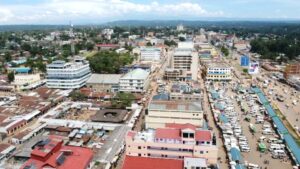KWS, rhino sites using AI-enabled cameras to stop black rhino poaching

Kenya’s drive to stop the poaching of the endangered black rhino species has got a boost after the installation of thermal cameras enabled with artificial intelligence (AI) in key rhino sites.
With support from the US Department of State Bureau of International Narcotics and Law Enforcement Affairs and the World Wide Fund for Nature (WWF), the Kenya Wildlife Service (KWS) has installed FLIR thermal cameras in three black rhino sites.
On World Rhino Day, marked every year on September 22, KWS and conservation partners will be celebrating the introduction of the AI-enabled cameras in Solio Game Reserve, Lake Nakuru National Park and Ol Pejeta Conservancy.
The Solio Game Reserve is the latest to get the FLIR thermal cameras. The sanctuary hosts over 30% of Kenya’s total rhino population.
The artificial intelligence-enabled FLIR cameras have inbuilt analytics that send out automated alerts every time they detect an intrusion from humans, vehicles or wildlife. This is one of the ways of equipping rangers with modern technology so that they are able to protect rhinos,” said Geoffrey Chege, Rhino Programme Coordinator, WWF-Kenya, at the handing over ceremony at Solio Game Reserve.
The idea is to minimize intrusion, including poachers, said Mohamed Awer, Chief Executive Officer, WWF-Kenya, adding that the strategy is to use technology to complement the good work done by rangers.
Kevin Carr-Hartley, Manager, Solio Game Reserve, said that the rhino sanctuary has the highest density of black rhinos in East Africa.
The FLIR cameras also protect the lives of rangers by providing crucial information about intruders location, minimizing the amount of time it takes to respond to alerts.
“Rangers are the most important people, they are on the frontline and we have to give them the technology that potential poachers might have. We have to be better and keep improving the technology like the FLIR cameras” added Carr-Hartley.
Solio Game Reserve has been one of the most successful rhino sites, providing founder population to over 90% of all rhino sites in Kenya. Despite these successes, Solio has witnessed high poaching rates in the past.
In the recent past, rhino poaching in Kenya has reduced even reaching zero in 2020, but the threat of poaching still persists.
“It is great that technology is always giving us new solutions, a new potential answer to all problems, and A.I is one of those. All of our thermal cameras have AI and can tell you when a human is in the picture or an animal. And then it will send an alert to the rangers. The rangers know immediately, if there is something that needs to be checked on the camera, and it is all based on A.I.,” said Colby Loucks, Vice President of Wildlife Conservation, WWF-US.




